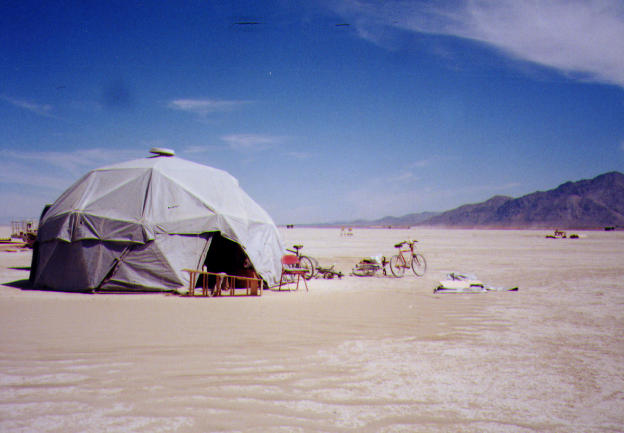Step 3: Glue the eyelets
Now for the part I did today. I invited my father-in-law (neighbor not too keen on hours of tedious labor) for: free lunch at his favorite place, Follow Your Heart, and free brewskies, in quid-pro-quo for helping me glue 330 eyelets in 165 bamboo poles. He assented readily, but complained after we were done.
It took us about three hours, working in assembly-line fashion: he applied glue to the hollow bamboo tube, and reamed out any pith that might be there, and I stuck the eyelet in the hole and applied more glue.

The hardest part for me was finding a place to lay all those poles flat. Eventually, I settled on the lawn behind my house, since it's flat, and the grass seemed to support the rings nicely.
The trick is to lay the sticks so that the eyelets are parallel. Most of the time, the big end of the bamboo was too big for even a #4 eyelet, while the small end took a #8 eyelet easily, for example. This means there is plenty of wiggle-room, so rest the sticks on the ground carefully!
The major problem was nodes. The node of the bamboo rod is solid wood, and doesn't like to have an eyelet screwed into it. The stick cracks if you screw too hard, basically. A cracked stick is not very supportive, though I did experiment a little with sealing cracks with glue. Basically this sealing process created a mess, with Gorilla Glue all over, and I have yet to examine closely the finished result. Better to drill holes in the ten or twenty sticks that have a node in the wrong place. This was a little frustrating. Next time, when you're cutting sticks, make a separate pile for the ones with nodes on the ends, and just drill small holes in these.

Besides making a bloody mess, the operation was successful. Gorilla Glue is very messy, and it doesn't combine well with newsprint. My fingers got pretty dirty from laying the rods on newspaper, and the dirt didn't wash off with soap, water, alcohol, windex, formula 409, or nail polish remover. So heed the warning--wear gloves for the gluing process and even for cleanup.
The reason the Gorilla Glue is so desireable is that it foams. I tried Titebond wood glue, DAP caulk, and another brand of caulk, but the Gorilla Glue won the contract for me. It's more expensive than the other glues out there, but it is best suited for this task, by far.
Day 2 update: all the rings stayed in the holes, and stayed straight. The glue foamed, and everything is super solid x 165 struts. The best place to put the drying rods is on (clean) grass, since this eliminates the newsprint problem. Try not to move the drying struts around before they are dry, since then you have to reorient the rings to be parallel.
The rings are parallel with the struts, while desertdomes.com recommends a 20-degree offset. I think the flexibility of the bamboo will (hopefully) compensate for the flatness of the rings, though we will find out when I construct the dome.





